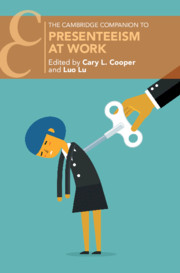Book contents
- Presenteeism at Work
- Cambridge Companions to Management
- Presenteeism at Work
- Copyright page
- Contents
- Contributors
- Foreword
- Introduction
- Part I Situating Presenteeism on the Global Stage
- 1 Presenteeism: An Introduction to a Prevailing Global Phenomenon
- 2 Presenteeism: A Critical Review of the Literature
- 3 Understanding the Excessive Availability for Work in the Confucian Asia: Interactions between Sociocultural Forces and Personal Drives
- Part II Understanding the Behavior of Presenteeism
- Part III Understanding the Consequences of Presenteeism
- Part IV Understanding Presenteeism in a Cross-Cultural Context
- Index
- References
2 - Presenteeism: A Critical Review of the Literature
from Part I - Situating Presenteeism on the Global Stage
Published online by Cambridge University Press: 09 August 2018
- Presenteeism at Work
- Cambridge Companions to Management
- Presenteeism at Work
- Copyright page
- Contents
- Contributors
- Foreword
- Introduction
- Part I Situating Presenteeism on the Global Stage
- 1 Presenteeism: An Introduction to a Prevailing Global Phenomenon
- 2 Presenteeism: A Critical Review of the Literature
- 3 Understanding the Excessive Availability for Work in the Confucian Asia: Interactions between Sociocultural Forces and Personal Drives
- Part II Understanding the Behavior of Presenteeism
- Part III Understanding the Consequences of Presenteeism
- Part IV Understanding Presenteeism in a Cross-Cultural Context
- Index
- References
Summary
This chapter presents a critical review of the literature on presenteeism. The goal is to summarize and identify the main conceptual and methodological limitations of presenteeism. More specifically, we critically review the presenteeism literature with a view to suggesting future research avenues that take into account the dynamic aspects of this phenomenon. First, some of the most popular and widely used definitions of presenteeism are presented along with their limitations. Then, we consider the various measures of presenteeism and suggest some improvements. Finally, we present methodological limitations based on an overview of research and current thinking in the field. This chapter highlights the methodological importance of considering small and medium-sized enterprises (SMEs) in future research.
- Type
- Chapter
- Information
- Presenteeism at Work , pp. 35 - 68Publisher: Cambridge University PressPrint publication year: 2018

